Gene Action, Heterotic Patterns, and Inter-Trait Relationships of Early Maturing Pro-Vitamin A Maize Inbred Lines and Performance of Testcrosses under Contrasting Environments
Abstract
:1. Introduction
2. Materials and Methods
2.1. Development of PVA Maize Inbred Lines
2.2. Generation of the Diallel Crosses
2.3. Field Evaluations
2.4. Kernel Samples Production for Quantification of PVA Contents
2.5. Data Collection
2.6. Statistical Analysis
3. Results
Analysis of Variance and Combining Ability of Grain Yield and Other Agronomic Traits
4. Discussion
5. Conclusions
Supplementary Materials
Author Contributions
Funding
Institutional Review Board Statement
Informed Consent Statement
Data Availability Statement
Conflicts of Interest
References
- Shiferaw, B.; Prasanna, B.; Hellin, J.; Banziger, M. Feeding a hungry world: Past successes and future challenges to global food security in maize. Food Secur. 2011, 3, 307–327. [Google Scholar] [CrossRef] [Green Version]
- Rosegrant, M.W.; Msangi, S.; Ringler, C.; Sulser, T.B.; Zhu, T.; Cline, S.A. Model for Policy Analysis of Agricultural Commodities and Trade (IMPACT): Model Description; International Food Policy Research Institute: Washington, DC, USA, 2008. [Google Scholar]
- Tester, M.; Langridge, P. Breeding technologies to increase crop production in a changing world. Science 2008, 327, 818–822. [Google Scholar] [CrossRef]
- WHO. Global Prevalence of Vitamin A Deficiency in Populations at Risk 1995–2005. In WHO Global Database on Vitamin A Deficiency; World Health Organization: Geneva, Switzerland, 2009; pp. 1–55. [Google Scholar]
- Daryanto, S.; Wang, L.; Jacinthe, P. Global synthesis of drought effect on maize and wheat. PLoS ONE 2016, 11, e0156362. [Google Scholar] [CrossRef]
- Anami, S.; De Block, M.; Machuka, J.; Van Lijsebettens, M. Molecular improvement of tropical maize for drought stress tolerance in sub-Saharan Africa. Crit. Rev. Plant Sci. 2009, 28, 16–35. [Google Scholar] [CrossRef]
- Badu-Apraku, B.; Menkir, A.; Ajala, S.O.; Akinwale, R.O.; Oyekunle, M.; Obeng-Antwi, K. Performance of tropical early-maturing maize cultivars in multiple stress environments. Can. J. Plant Sci. 2010, 90, 1–22. [Google Scholar] [CrossRef] [Green Version]
- Badu-Apraku, B.; Lum, A.F. Agronomic performance of Striga resistant early-maturing maize varieties and inbred lines in the savannas of West and Central Africa. Crop Sci. 2007, 47, 737–750. [Google Scholar] [CrossRef]
- Akinwale, R.O.; Badu-Apraku, B.; Fakorede, M.A.B.; Vroh-Bi, I. Heterotic grouping of tropical early-maturing maize inbred lines based on combining ability in Striga-infested and Striga-free environments and the use of SSR markers for genotyping. Field Crop. Res. 2014, 156, 48–62. [Google Scholar] [CrossRef]
- Lagoke, S.T.O.; Parkinson, V.; Agunbiade, R.M. Parasitic weeds and control methods in Africa. In Proceedings of the International Workshop on Combating Striga in Africa, IITA, Ibadan, Nigeria, 22–24 August 1988; pp. 3–14. [Google Scholar]
- Kim, S.K. Genetics of maize tolerance of Striga hermonthica. Crop Sci. 1994, 34, 900–907. [Google Scholar] [CrossRef]
- Badu-Apraku, B.; Fakorede, M.A.B.; Lum, A.F. Evaluation of experimental varieties from recurrent selection for Striga resistance in two extra-early maize populations in the savannas of West and Central Africa. Exp. Agric. 2006, 43, 183–200. [Google Scholar] [CrossRef]
- Kim, S.K. Breeding maize for Striga tolerance and the development of a field infestation technique. In Combating Striga in Africa, Proceedings of the International Workshop Organized by IITA, ICRISAT, and IDRC, IITA, Ibadan, Nigeria, 22–24 August 1988; Kim, S.K., Ed.; pp. 96–108.
- Badu-Apraku, B.; Fakorede, M.A.B.; Menkir, A.; Kamara, A.Y.; Adam, A. Effects of drought-screening methodology on genetic variances and covariances in Pool 16 DT maize population. J. Agric. Sci. 2004, 142, 445–452. [Google Scholar] [CrossRef]
- Cechin, I.; Press, M.C. The influence of nitrogen on growth and photosynthesis of sorghum infected with Striga hermonthica from different provenances. Weed Res. 1993, 3, 289–298. [Google Scholar] [CrossRef]
- Kim, S.K.; Adetimirin, V.O. Responses of tolerant and susceptible maize varieties to timing and rate of nitrogen under Striga hermonthica infestation. Agron. J. 1997, 89, 38–44. [Google Scholar] [CrossRef]
- Banzigar, M.; Lafitte, H.R. Efficiency of secondary traits for improving maize for low-Nitrogen target environments. Crop Sci. 1997, 37, 1110–1117. [Google Scholar] [CrossRef]
- Wolfe, D.W.; Henderson, D.C.; Hsiao, T.C.; Alvio, A. Interactive water and nitrogen effects on maize. II. Photosynthetic decline and longevity of individual leaves. Agron. J. 1988, 80, 865–870. [Google Scholar] [CrossRef]
- Nigussie, M.; Zelleke, H. Heterosis and combining ability in a diallel among eight elite maize populations. Afr. Crop Sci. J. 2001, 9, 471–479. [Google Scholar] [CrossRef]
- Zeinab, G.E.; Helal, A.G. Diallel analysis and separation of genetic variance components in eight faba bean genotypes. Ann. Agric. Sci. 2014, 59, 147–154. [Google Scholar] [CrossRef] [Green Version]
- Beck, D.L.; Vasal, S.K.; Crossa, J. Heterosis and combining ability among subtropical and temperate intermediate maturity maize germplasm. Crop Sci. 1991, 31, 68–73. [Google Scholar] [CrossRef]
- Bhatnagar, S.; Betrán, F.J.; Rooney, L.W. Combining abilities of quality protein maize inbreds. Crop Sci. 2004, 44, 1997–2005. [Google Scholar] [CrossRef] [Green Version]
- Menkir, A.; Badu-Apraku, B.; The, C.; Adepoju, A. Evaluation of heterotic patterns of IITA lowland white maize inbred lines. Maydica 2003, 48, 161–170. [Google Scholar]
- Gethi, J.G.; Smith, M.E. Genetic responses of single crosses of maize to Striga hermonthica (Del.) Benth. and Striga asiatica (L.) kuntze. Crop Sci. 2004, 44, 2068–2077. [Google Scholar] [CrossRef]
- Badu-Apraku, B.; Abamu, F.J.; Menkir, A.; Fakorede, M.A.B.; Obeng-Antwi, K. Genotype by environment interactions in the regional early variety trials in West and Central Africa. Maydica 2003, 48, 93–104. [Google Scholar]
- Moghaddam, M.; Pourdad, S. Comparison of Parametric and Non-parametric Methods for Analysing Genotype × Environment Interactions in Safflower (Carthamus tinctorius L.). J. Agric. Sci. 2009, 147, 601. [Google Scholar] [CrossRef]
- FAO. World Reference Base for Soil Resources: A Framework for International Classification, Correlation and Communication; FAO: Rome, Italy, 2006; p. 103. [Google Scholar]
- Kim, S.K.; Winslow, M.D. Progress in Breeding Maize for Striga-Tolerance/Resistance at IITA. In Proceedings of the 5th International Symposium Parasitic Weeds, Nairobi, IITA, Ibadan, Nigeria, 24–30 June 1991; Ransom, J.K., Ed.; pp. 494–499. [Google Scholar]
- Bremner, J.M.; Mulvaney, C.S. Nitrogen-total. In Methods of Soil Analysis. Part 2, 2nd ed.; Page, A.L., Ed.; Agronomy Monographs Book Series; ASA and SSSA: Madison, WI, USA, 1982; pp. 595–624. [Google Scholar]
- Suwarno, W.B.; Pixley, K.V.; Palacios-Rojas, N.; Kaeppler, S.M.; Babu, R. Genome-wide association analysis reveals new targets for carotenoid biofortification in maize. Theor. Appl. Genet 2015, 128, 851–864. [Google Scholar] [CrossRef] [Green Version]
- Azmach, G.; Gedil, M.; Menkir, A.; Spillane, C. Marker-trait association analysis of functional gene markers for provitamin A levels across diverse tropical yellow maize inbred lines. BMC Plant Biol. 2013, 13, 227. [Google Scholar]
- Howe, J.A.; Tanumihardjo, S.A. Evaluation of analytical methods for carotenoid extraction from biofortified maize (Zea mays sp). J. Agric. Food Chem. 2006, 54, 7992–7997. [Google Scholar] [CrossRef] [PubMed]
- US Institute of Medicine. Dietary Reference Intakes for Vitamin A, Vitamin K, Arsenic, Boron, Chromium, Copper, Iodine, Iron, Manganese, Molybdenum, Nickel, Silicon, Vanadium, and Zinc; The National Academies Press: Washington, DC, USA, 2001. [Google Scholar]
- SAS Institute Inc. Base SAS®9. 3 Procedures Guide; SAS Institute Inc.: Cary, NC, USA, 2011. [Google Scholar]
- Griffing, B. Concept of general and specific combining ability in relation to diallel crossing systems. Aust. J. Biol. Sci. 1956, 9, 463–493. [Google Scholar] [CrossRef]
- Zhang, Y.; Kang, M.; Lamkey, K. DIALLEL-SAS05: A comprehensive program for griffing’s and Gardner-Eberhart analyses. Agron. J. 2005, 97, 1097–1106. [Google Scholar] [CrossRef]
- Baker, R.J. Issues in diallel analysis. Crop Sci. 1978, 18, 533–536. [Google Scholar] [CrossRef]
- Hung, H.Y.; Holland, J.B. Diallel analysis of resistance to fusarium ear rot and fumonium contamination in maize. Crop Sci. 2012, 52, 2173–2181. [Google Scholar] [CrossRef] [Green Version]
- Badu-Apraku, B.; Oyekunle, M.; Fakorede, M.A.B.; Vroh, I.; Akinwale, R.O.; Aderounmu, M. Combining ability, heterotic patterns and genetic diversity of extra-early yellow inbreds under contrasting environments. Euphytica 2013, 192, 413–433. [Google Scholar] [CrossRef]
- Fan, X.M.; Zhang, Y.M.; Yao, W.H.; Chen, H.M.; Tan, J.; Xu, C.X.; Han, X.L.; Luo, L.M.; Kang, M.S. Classifying maize inbred lines into heterotic groups using a factorial mating design. Agron. J. 2009, 101, 106–112. [Google Scholar] [CrossRef]
- Pacheco, A.; Vargas, M.; Alvarado, G.; Rodríguez, F.; Crossa, J.; Burgueño, J. GEA-R (Genotype × Environment Analysis with R for Windows). Version 2.0. CIMMYT. Available online: http://hdl.handle.net/11529/10203 (accessed on 20 June 2016).
- Badu-Apraku, B.; Fakorede, M.A.B.; Oyekunle, M.; Akinwale, R.O. Selection of extra-early maize inbreds under low N and drought at flowering and grain-filling for hybrid production. Maydica 2011, 56, 1721–1735. [Google Scholar]
- Badu-Apraku, B.; Annor, B.; Oyekunle, M.; Akinwale, R.O.; Fakorede, M.A.B.; Talabi, A.O.; Akaogu, I.C.; Melaku, G.; Fasanmade, Y. Grouping of early maturing quality protein maize inbreds based on SNP markers and combining ability under multiple environments. Field Crop. Res. 2015, 183, 169–183. [Google Scholar] [CrossRef] [Green Version]
- Badu-Apraku, B.; Oyekunle, M. Genetic analysis of grain yield and other traits of extra-early yellow maize inbreds and hybrid performance under contrasting environments. Field Crop. Res. 2012, 129, 99–110. [Google Scholar] [CrossRef]
- Oyekunle, M.; Badu-Apraku, B. Assessment of interrelationships among grain yield and secondary traits of early-maturing maize inbred lines under drought and well-watered conditions. Maydica 2018, 63, 1–10. [Google Scholar]
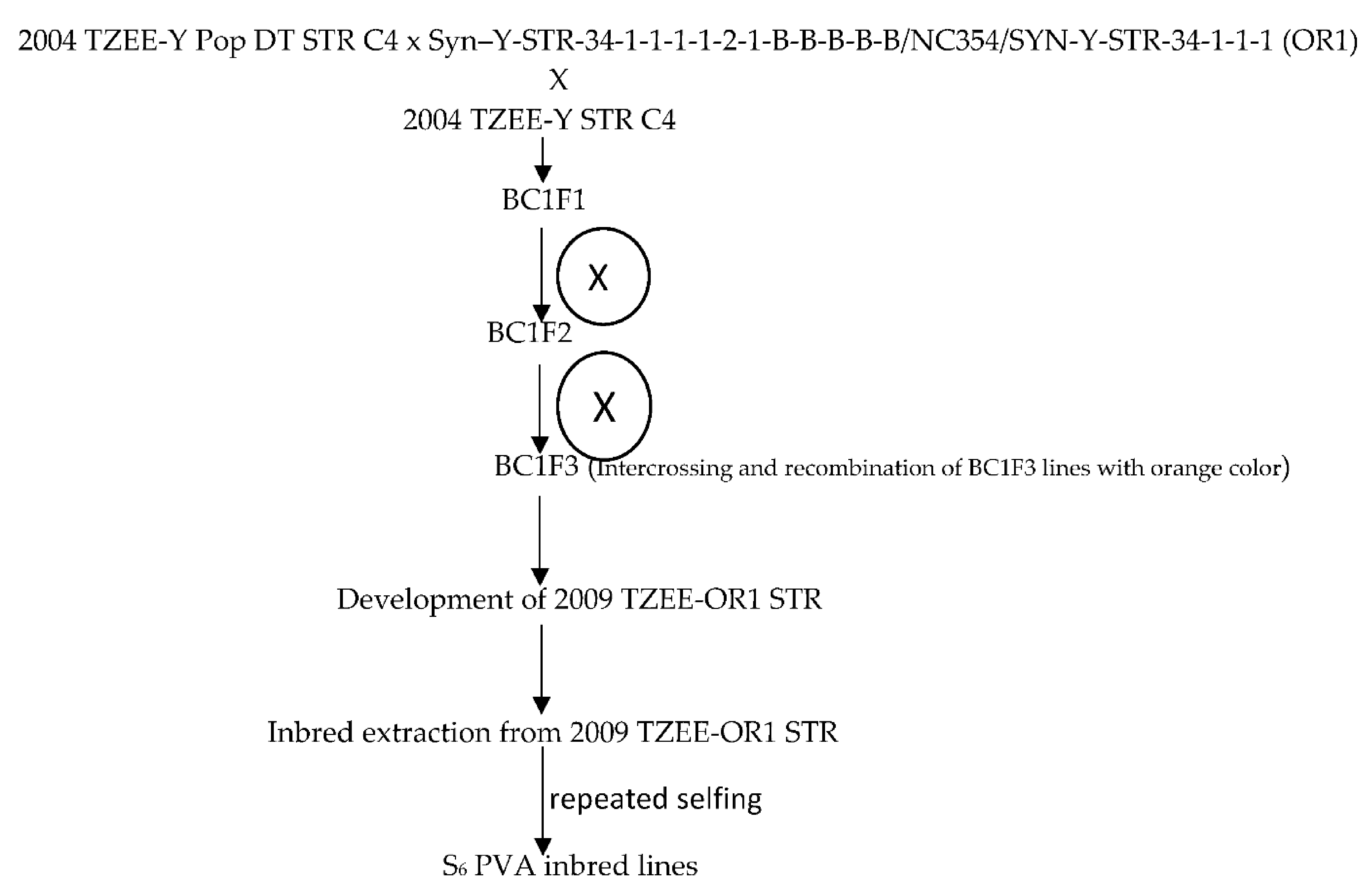

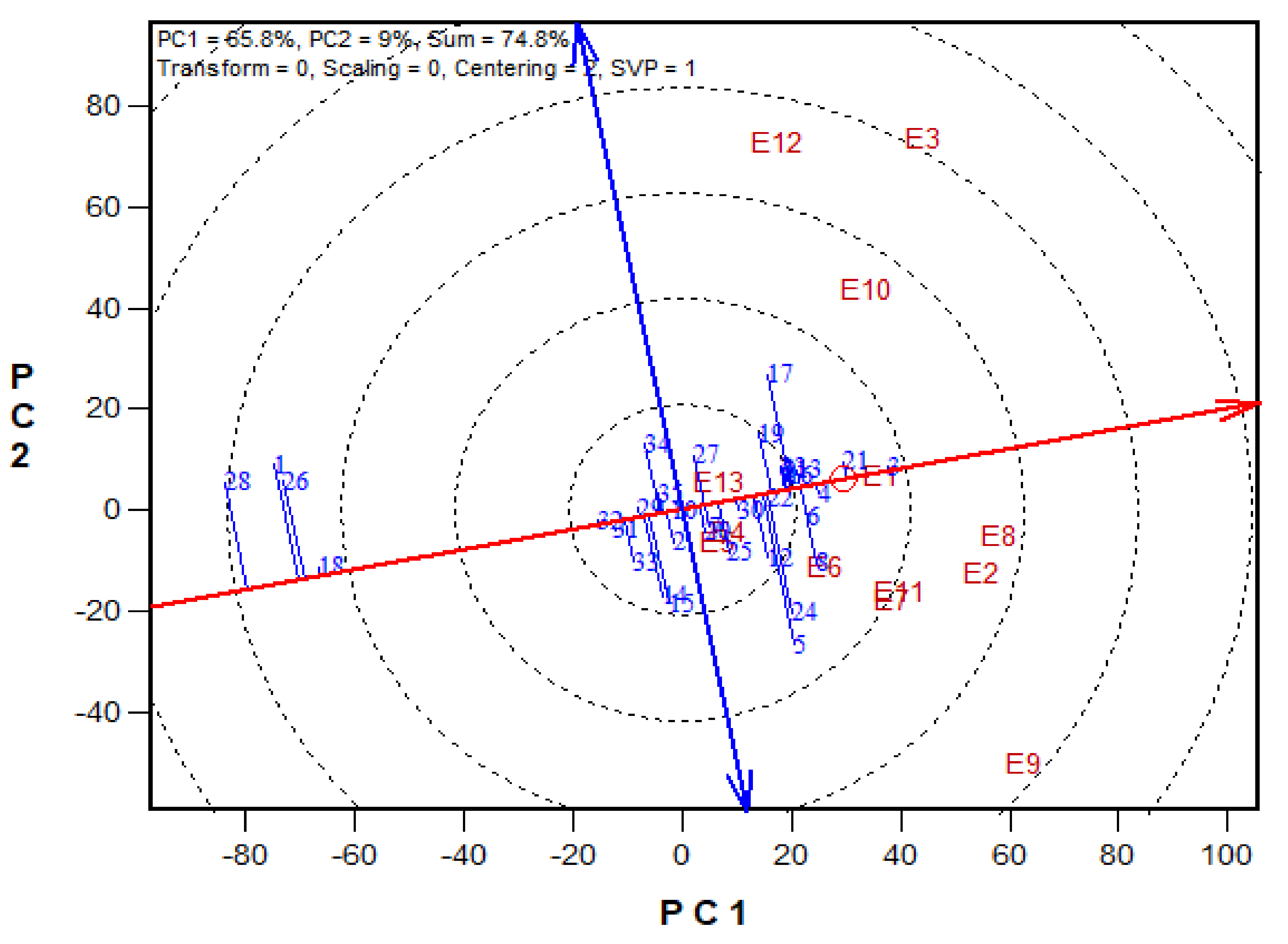

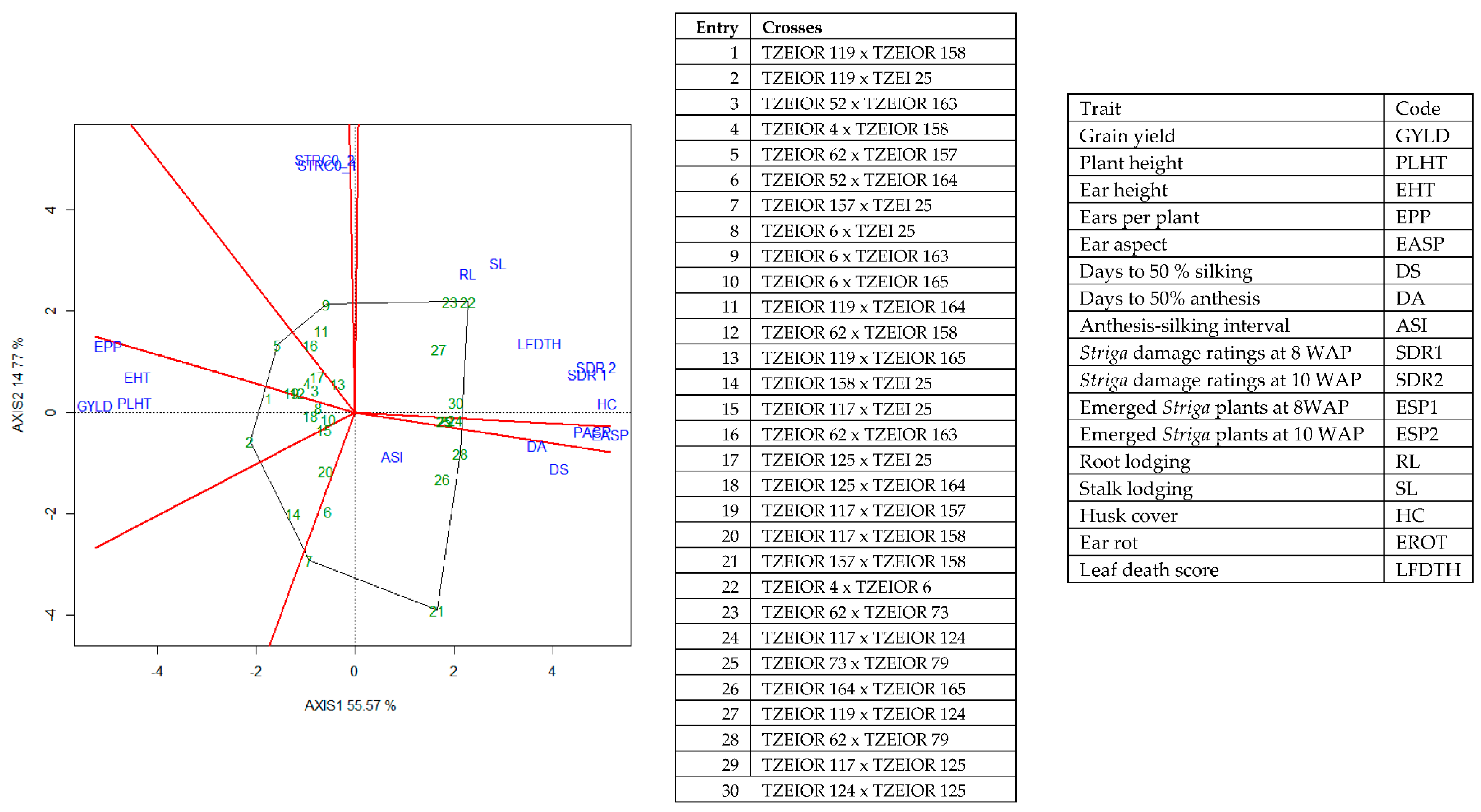

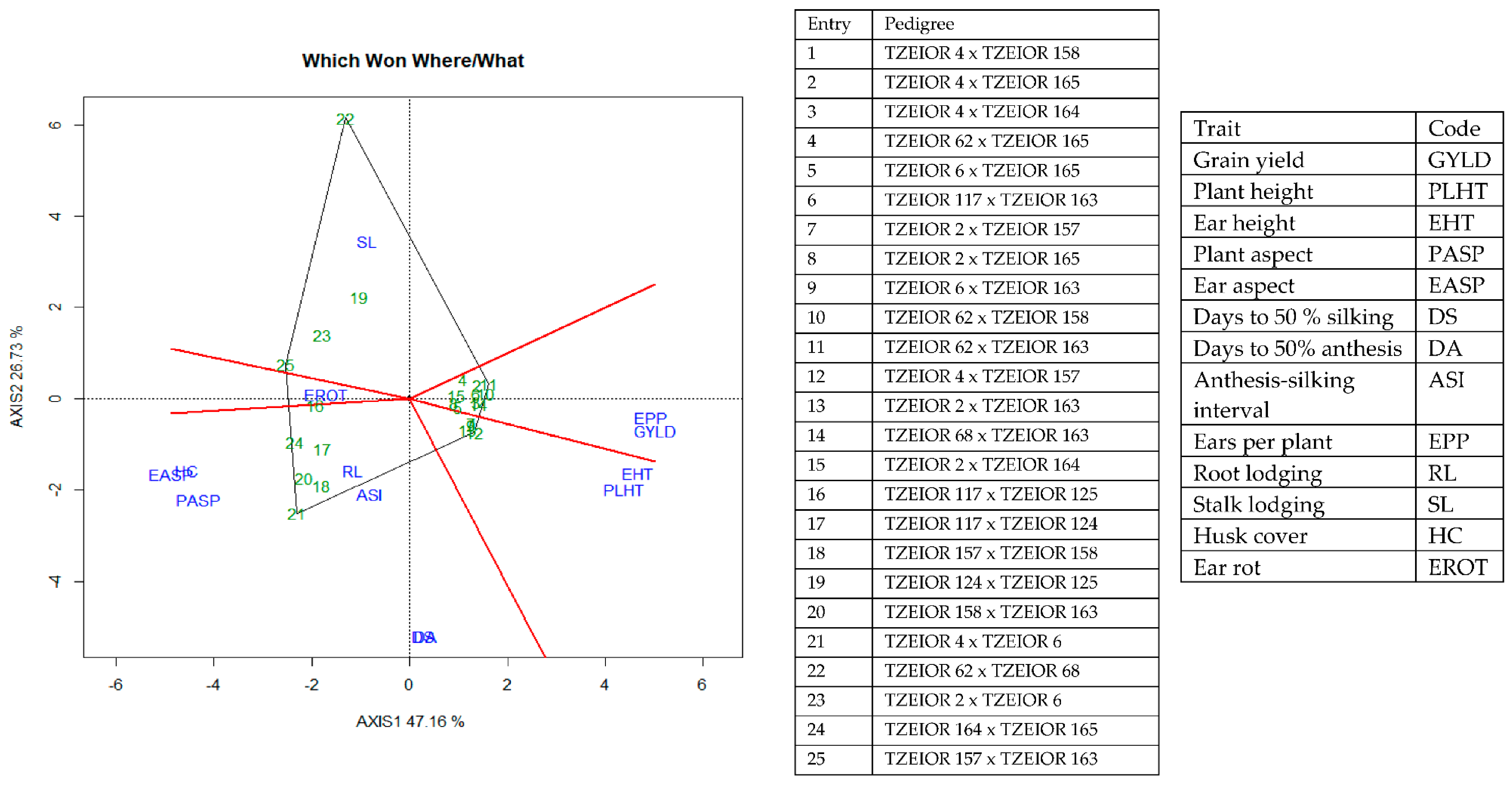
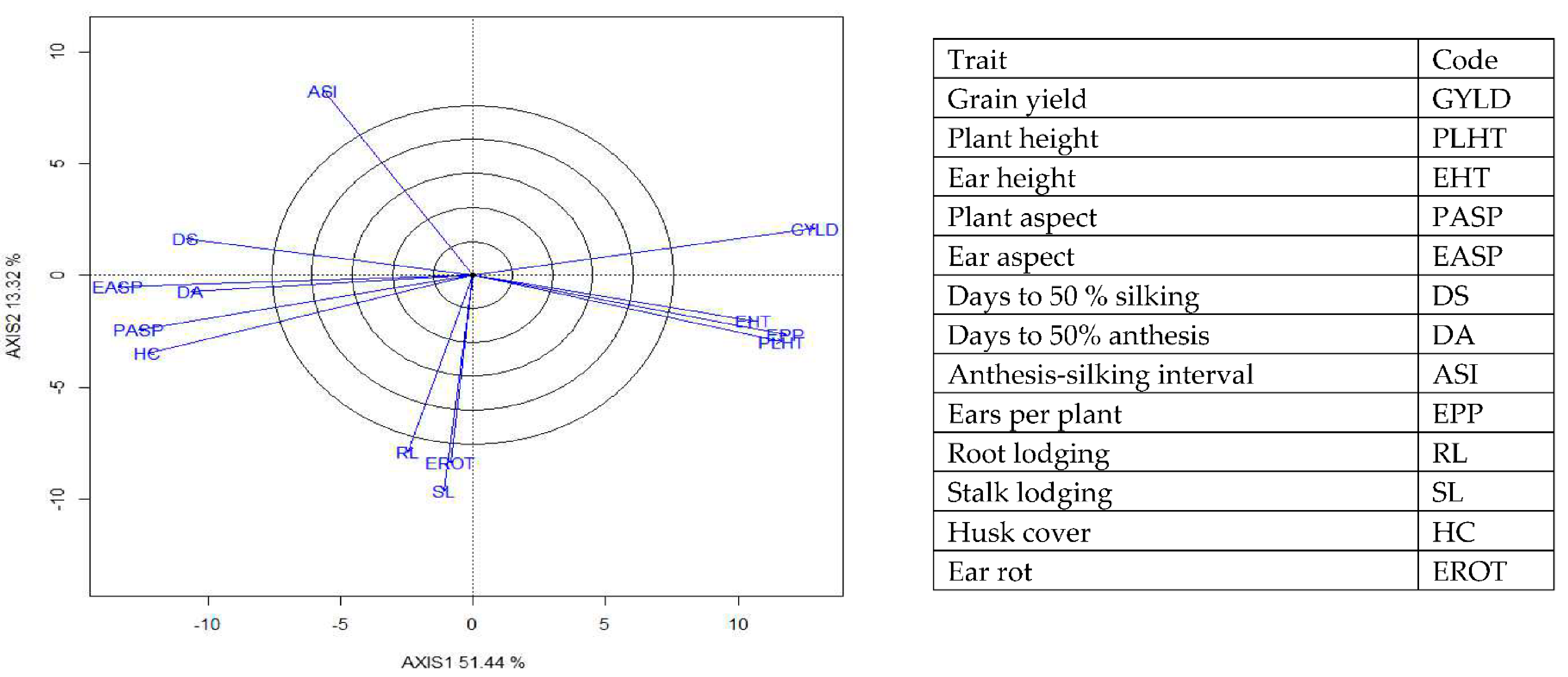
| S/N | Pedigree | Parentage | Reaction to Stress | Provitamin A Content (µg/g) | |
|---|---|---|---|---|---|
| Drought | Striga Hermonthica | ||||
| 1 | TZEIOR 2 | 2009 TZE OR1 DT STR | Tolerant | Susceptible | 4.91 |
| 2 | TZEIOR 4 | 2010 TZE OR1 DT STR | Tolerant | Tolerant | 6.45 |
| 3 | TZEIOR 6 | 2011 TZE OR1 DT STR | Tolerant | Tolerant | 6.34 |
| 4 | TZEIOR 30 | 2012 TZE OR1 DT STR | Tolerant | Susceptible | 6.30 |
| 5 | TZEIOR 52 | 2013 TZE OR1 DT STR | Tolerant | Tolerant | 7.96 |
| 6 | TZEIOR 62 | 2014 TZE OR1 DT STR | Tolerant | Tolerant | 5.32 |
| 7 | TZEIOR 68 | 2015 TZE OR1 DT STR | Tolerant | Tolerant | 8.18 |
| 8 | TZEIOR 73 | 2016 TZE OR1 DT STR | Tolerant | Tolerant | 7.62 |
| 9 | TZEIOR 79 | 2017 TZE OR1 DT STR | Tolerant | Susceptible | 5.48 |
| 10 | TZEIOR 117 | 2018 TZE OR1 DT STR | Tolerant | Susceptible | 4.19 |
| 11 | TZEIOR 119 | 2019 TZE OR1 DT STR | Tolerant | Susceptible | 3.61 |
| 12 | TZEIOR 124 | 2020 TZE OR1 DT STR | Tolerant | Susceptible | 3.28 |
| 13 | TZEIOR 125 | 2021 TZE OR1 DT STR | Tolerant | Tolerant | 3.75 |
| 14 | TZEIOR 157 | (TZEI 17 × TZEI 11) | Susceptible | Tolerant | 4.42 |
| 15 | TZEIOR 158 | (TZEI 17 × TZEI 11) | Tolerant | Susceptible | 2.65 |
| 16 | TZEIOR 163 | (TZEI 17 × TZEI 11) | Tolerant | Tolerant | 2.95 |
| 17 | TZEIOR 164 | (TZEI 17 × TZEI 11) | Tolerant | Susceptible | 7.40 |
| 18 | TZEIOR 165 | (TZEI 17 × TZEI 11) | Susceptible | Tolerant | 4.50 |
| 19 | TZEI 25 | TZE-Y Pop STR Co | Tolerant | Tolerant | 5.30 |
| 20 | TZEI 129 | TZE-Y Pop STR Co | Tolerant | Tolerant | 8.16 |
| Source | DF | Yield | DA | DS | ASI | PLHT | EHT | RL | SL | HC | EASP | EROT | EPP | |
| Block (Rep*E) | 182 | 1,956,126 ** | 11.22 ** | 19.11 ** | 7.51 ** | 666.04 ** | 211.55 ** | 1.26 ** | 3.28 ** | 1.65 ** | 1.62 ** | 3.31 ** | 0.12 ** | |
| Rep (E) | 7 | 5,151,433 ** | 98.21 ** | 82.22 ** | 14.59 * | 4257.66 ** | 1820.75 ** | 2.56 ** | 8.94 ** | 7.18 ** | 13.98 ** | 185.93 ** | 0.56 ** | |
| Environment (E) | 6 | 454,529,301 ** | 2301.2 ** | 6066.04 ** | 2751.35 ** | 186,377.2 ** | 32,883.84 ** | 79.34 ** | 327.16 ** | 503.83 ** | 359.34 ** | 564.97 ** | 21.07 ** | |
| Genotype (G) | 189 | 2,760,720 ** | 24.97 ** | 26.25 ** | 7.59 ** | 671.91 ** | 211.10 ** | 1.54 ** | 4.20 ** | 1.79 ** | 2.72 ** | 2.57 ** | 0.14 ** | |
| GCA | 19 | 8,183,523 ** | 120.13 ** | 106.35 ** | 17.17 ** | 1994.47 ** | 445.45 ** | 5.75 ** | 18.19 ** | 6.17 ** | 5.77 ** | 6.94 ** | 0.18 ** | |
| SCA | 170 | 2,392,470 ** | 17.35 ** | 19.968 ** | 6.81 | 615.25 ** | 210.90 ** | 1.29 ** | 2.89 ** | 1.57 ** | 2.69 ** | 2.58 ** | 0.15 ** | |
| G × E | 1134 | 1,250,691 ** | 6.55 ** | 9.95 ** | 7.12 ** | 387.08 ** | 140.58 ** | 1.33 ** | 3.32 ** | 1.06 ** | 1.42 ** | 2.24 ** | 0.11 ** | |
| GCA*E | 114 | 3,570,297 ** | 6.94 | 16.93 ** | 11.25 ** | 648.03 ** | 218.14 ** | 2.87 ** | 7.22 ** | 15.25 ** | 19.53 ** | 4.48 ** | 0.22 ** | |
| SCA*E | 1020 | 1,258,890 ** | 7.2 ** | 10.98 ** | 7.01 ** | 416.46 ** | 149.06 ** | 1.24 ** | 3.01 ** | 6.60 ** | 8.48 ** | 2.18 ** | 0.09 * | |
| Error | 1140 | 525,278 | 5.44 | 7.36 | 5.50 | 311.66 | 113.68 | 0.86 | 2.02 | 0.71 | 0.873 | 1.60 | 0.08 | |
| Source | DF | PASP | STGR | Source | DF | RAT1 | RAT 2 | STRC0_1 | STRC0_2 | |||||
| Block (Rep*E) | 104 | 1.79 ** | 1.65 ** | Block (Rep*E) | 78 | 2.54 ** | 2.71 ** | 3.33 * | 2.86 ** | |||||
| Rep (E) | 4 | 7.18 ** | 15.29 ** | Rep(E) | 3 | 2.98 ** | 2.91 ** | 7.730 * | 7.45 ** | |||||
| Environment (E) | 3 | 322.12 ** | 423.02 ** | Environment (E) | 2 | 107.59 ** | 136.59 ** | 252.85 ** | 165.20 ** | |||||
| Genotype (G) | 189 | 1.62 ** | 1.10 ** | Genotype (G) | 189 | 3.22 ** | 3.78 ** | 3.04 * | 2.75 ** | |||||
| GCA | 19 | 2.35 ** | 2.70 ** | GCA | 19 | 1.85 ** | 2.11 ** | 2.76 ** | 2.41 ** | |||||
| SCA | 170 | 1.94 ** | 1.30 ** | SCA | 170 | 2.51 ** | 2.45 ** | 2.54 | 2.01 | |||||
| G × E | 567 | 1.17 ** | 0.93 ** | G × E | 378 | 2.08 ** | 2.05 ** | 2.54 | 2.01 | |||||
| GCA*E | 57 | 2.66 ** | 2.24 ** | GCA*E | 114 | 9.6633 | 8.6745 | 2.2 | 1.71 | |||||
| SCA*E | 510 | 1.25 ** | 0.98 ** | SCA*E | 1020 | 1.3976 | 1.4087 | 2.63 | 2.08 | |||||
| Error | 652 | 0.749654 | 0.67793 | Error | 489 | 0.778814 | 0.734521 | 2.407927 | 1.94947 | |||||
| Optimal Environments | ||||||||||
|---|---|---|---|---|---|---|---|---|---|---|
| Source of Variation | Df | Grain Yield, (kg/ha) | Days to Anthesis | Days to 50% Silk | ASI | Plant Height (cm) | Ear Height (cm) | Husk Cover | Ear Aspect | Ears/Plant |
| Block (Rep*E) | 156 | 2,572,781 ** | 6.8 ** | 7.6 ** | 0.5 | 429.5 ** | 218.6 ** | 0.8 ** | 0.8 ** | 0.02 ** |
| Rep (E) | 6 | 33,916,855 ** | 55.2 ** | 58.9 ** | 1.1 * | 4806.1 ** | 1888.7 ** | 10.5 ** | 9.8 ** | 0.08 ** |
| Environment (E) | 5 | 1,602,594,010 ** | 770.7 ** | 451.2 ** | 213.9 ** | 212,914.3 ** | 46,556.3 ** | 1323.5 ** | 390.3 ** | 7.06 ** |
| Genotype (G) | 189 | 14,131,291 ** | 23.9 ** | 30.3 ** | 2.1 ** | 1213.9 ** | 432.5 ** | 4.3 ** | 6.2 ** | 0.11 ** |
| GCA | 19 | 9,372,017 * | 99.1 ** | 136.1 ** | 12.5 ** | 3921.6 ** | 1238.4 ** | 4.2 | 4.7 ** | 0.21 ** |
| SCA | 170 | 15,600,485 ** | 18.1 ** | 21.8 ** | 1.0 | 1013.1 * | 385.2 ** | 4.6 | 6.8 ** | 0.11 ** |
| G × E | 945 | 1,637,692 ** | 2.9 ** | 3.6 ** | 0.8 ** | 305.6 ** | 132.0 ** | 1.1 ** | 0.7 ** | 0.03 ** |
| GCA*E | 95 | 2,749,325 ** | 2.0 | 2.2 | 1.4 ** | 580.3 ** | 264.4 ** | 1.6 ** | 0.9 ** | 0.05 ** |
| SCA*E | 850 | 1,758,594 ** | 3.7 ** | 4.2 ** | 0.7 ** | 328.7 ** | 136.2 ** | 1.2 ** | 0.8 ** | 0.03 ** |
| Error | 1014 | 946,352 | 1.7 | 2 | 0.4 | 185.5 | 100 | 0.6 | 0.5 | 0.01 |
| Across environments | ||||||||||
| Block (Rep*E) | 338 | 2,255,103 ** | 8.7 ** | 13.4 ** | 3.7 ** | 549.4 ** | 207.3 ** | 1.2 ** | 1.3 ** | 0.05 ** |
| Rep (E) | 13 | 19,213,986 ** | 83.9 ** | 74.8 ** | 9.6 ** | 4697.8 ** | 2009.8 ** | 9.3 ** | 13.2 ** | 0.36 ** |
| Environment (E) | 12 | 1,851,902,351 ** | 1794.4 ** | 4904.3 ** | 2011.6 ** | 291,143.7 ** | 62,019.4 ** | 1028.5 ** | 474.1 ** | 23.56 ** |
| Genotype (G) | 189 | 12,220,910 ** | 44.7 ** | 50.9 ** | 5.4 ** | 1505.3 ** | 466.1 ** | 4.4 ** | 7.0 ** | 0.15 ** |
| GCA | 19 | 12,793,056.2 ** | 213.2 ** | 230.4 ** | 25.8 ** | 4694.6 ** | 1201.0 ** | 8.7 ** | 5.9 ** | 0.18 * |
| SCA | 170 | 12,928,333.76 ** | 30.6 ** | 35.9 ** | 3.5 ** | 1243.8 | 411.8 ** | 4.3 * | 7.6 ** | 0.17 ** |
| G × E | 2268 | 1,667,261 ** | 4.7 ** | 7.0 ** | 3.6 ** | 356.8 ** | 143.7 ** | 1.1 ** | 1.1 ** | 0.04 ** |
| GCA*E | 228 | 3,315,645 ** | 5.2 ** | 10.4 ** | 6.5 ** | 628.6 ** | 256.6 ** | 2.1 ** | 2.3 ** | 0.11 ** |
| SCA*E | 2040 | 1,729,213 ** | 5.3 ** | 7.8 ** | 3.5 ** | 381.5 ** | 148.9 ** | 1.2 ** | 1.1 ** | 0.04 ** |
| Error | 2197 | 744,268 | 3.3 | 4.8 | 2.6 | 249.7 | 107.4 | 0.7 | 0.7 | 0.02 |
| INBRED | Grain Yield (Kg/ha) | Days to Silk | Days to Anthesis | Plant Aspect | ||||||||
|---|---|---|---|---|---|---|---|---|---|---|---|---|
| STR | NON-STR | ACR | STR | NON-STR | ACR | STR | N0N-STR | ACR | STR | NON-STR | ACR | |
| TZEIOR 2 | −144.15 | 53.49 | −21.24 | 0.61 * | 1.15 ** | 0.77 ** | 0.56 * | 0.25 ** | 0.63 ** | −0.01 | −0.14 * | −0.11 * |
| TZEIOR 4 | −3.43 | 399.83 ** | 208.41 | 0.33 | 0.50 ** | 0.45 ** | 0.26 | 0.15 * | 0.34 ** | 0.04 | −0.15 * | −0.11 |
| TZEIOR 6 | −0.98 | 78.95 | 41.75 | 0.41 | 1.05 ** | 0.67 ** | 0.3 | 0.14 | 0.65 ** | 0.18 | −0.12 * | −0.058 |
| TZEIOR 30 | −263.31 ** | 128.09 | −55.24 | −0.08 | −0.68 ** | −0.39 ** | 0.06 | −0.16 * | −0.34 ** | −0.09 | −0.14 * | −0.071 |
| TZEIOR 52 | 303.48 ** | 58.22 | 180.15 | 0.14 | 0.38 ** | 0.40 ** | 0.61 ** | −0.06 | 0.55 ** | −0.16 | −0.1 | −0.078 |
| TZEIOR 62 | −35.66 | −151.5 | −139.77 | 0.29 | 0.27 | 0.41 ** | 0.61 ** | −0.31 ** | 0.62 ** | −0.04 | 0.02 | 0.018 |
| TZEIOR 68 | −75.14 | 16.99 | −31.43 | 0.34 | 0.001 | 0.1 | 0.48 * | −0.21 ** | 0.25 | 0.11 | 0.13 * | 0.19 |
| TZEIOR 73 | −73.8 | −34.36 | −45.74 | 0.88 ** | 0.29 * | 0.63 ** | 1.11 ** | −0.26 ** | 0.73 ** | −0.04 | 0.15 ** | 0.079 |
| TZEIOR 79 | −375.45 ** | −442.41 ** | −501.82 ** | 0.72 * | 0.32 * | 0.66 ** | 0.74 ** | −0.17 * | 0.70 ** | 0.03 | 0.21 ** | 0.19 ** |
| TZEIOR 117 | −4.01 | −25.38 | 1.91 | −1.11 ** | −1.49 ** | −1.33 ** | −1.03 ** | −0.30 ** | −1.05 ** | 0.24 * | 0.29 ** | 0.22 ** |
| TZEIOR 119 | 175.29 | −79.74 | 80.72 | −1.09 ** | −1.41 ** | −1.36 ** | −1.28 ** | −0.12 | −1.20 ** | −0.1 | 0.09 | 0.001 |
| TZEIOR 124 | −249.35 ** | −392.22 * | −331.84 ** | −0.14 | −0.23 | −0.1 | −0.18 | 0.03 | −0.13 | 0.002 | 0.09 | 0.041 |
| TZEIOR 125 | −155.19 | −293.39 | −244.96 * | −0.48 | −0.60 ** | −0.61 ** | −0.55 * | −0.04 | −0.54 ** | 0.05 | 0.03 | 0.01 |
| TZEIOR 157 | 71.02 | 50.04 | 18.67 | 0.71 * | 0.56 ** | 0.66 ** | 0.44 * | 0.34 ** | 0.40 ** | 0.06 | −0.02 | 0.001 |
| TZEIOR 158 | 156.7 | −73.8 | 32.2 | 0.62 * | 1.19 ** | 0.88 ** | 0.55 * | 0.55 ** | 0.55 ** | −0.02 | 0.03 | −0.004 |
| TZEIOR 163 | 228.21 * | −12.9 | 92.57 | 0.19 | 0.60 ** | 0.53 ** | −0.24 | 0.27 ** | 0.19 | −0.16 | −0.01 | −0.039 |
| TZEIOR 164 | 144.26 | 181.9 | 234.097 * | −0.42 | −0.37 * | −0.51 ** | −0.78 ** | 0.13 | −0.66 ** | 0.11 | 0.03 | 0.033 |
| TZEIOR 165 | 114.71 | 71.6 | 123.34 | −0.5 | −0.37 * | −0.46 ** | −0.91 ** | 0.18 * | −0.68 ** | 0.14 | 0.1 | 0.13 * |
| TZEI 25 | 219.01 * | 151.53 | 222.68 * | −0.11 | 0.03 | −0.2 | 0.12 | −0.1 | −0.08 | −0.08 | −0.28 ** | −0.28 ** |
| TZEI 129 | −32.2 | 315.08 * | 135.53 | −1.33 ** | −1.21 ** | −1.21 ** | −0.88 ** | −0.28 ** | −0.95 ** | −0.28 * | −0.19 ** | −0.17 ** |
| TZEIOR 2 | 0.15 | −0.02 | 0.055 | −0.03 | 0.013 | −0.012 | 0.03 | 0.02 | 0.36 ** | 0.34 ** | 5.80 * | 7.44 ** |
| TZEIOR 4 | 0.001 | −0.14 | −0.084 | −0.02 | −0.005 | −0.018 | 0.34 * | 0.09 | 0.17 | 0.22 | 8.04 ** | 8.29 ** |
| TZEIOR 6 | 0.11 | −0.05 | 0.002 | −0.01 | 0.004 | −0.0001 | 0.16 | 0.07 | −0.21 | −0.11 | 7.71 ** | 8.23 ** |
| TZEIOR 30 | 0.24 ** | −0.14 | 0.098 | −0.04 | 0.015 | −0.021 | −0.33 * | 0.16 | 0.63 ** | 0.61 ** | 5.11 * | 5.64 * |
| TZEIOR 52 | −0.26 ** | −0.17 * | −0.22 ** | 0.04 | 0.009 | 0.03 * | −0.41 ** | 0.04 | −0.91 ** | −0.95 ** | −4.66 | −5.56 * |
| TZEIOR 62 | −0.02 | −0.09 | −0.035 | 0.01 | 0.059 ** | 0.04 ** | 0 | 0.13 | 0.06 | 0.04 | 4.35 | 4.80 * |
| TZEIOR 68 | 0.01 | −0.07 | 0.007 | 0.01 | 0.022 | 0.029 | 0.07 | 0.23 | 0.11 | 0.14 | 3.14 | 4.14 |
| TZEIOR 73 | 0.03 | −0.15 | −0.091 | −0.003 | 0.037 ** | 0.015 | −0.13 | 0.2 | 0.42 ** | 0.53 ** | 5.20 * | 4.74 * |
| TZEIOR 79 | 0.27 ** | 0.12 | 0.23 ** | 0.01 | 0.053 ** | 0.023 | −0.23 | 0.16 | 0.41 ** | 0.52 ** | 2.58 | 2.09 |
| TZEIOR 117 | −0.02 | 0.15 | 0.039 | −0.01 | 0.011 | 0.002 | 0.35 ** | −0.09 | 0.32 * | 0.36 ** | −5.34 * | −5.82 * |
| TZEIOR 119 | −0.21 * | 0.06 | −0.104 | 0.004 | −0.003 | 0.001 | 0.02 | −0.2 | −0.06 | −0.06 | 1.36 | 1.72 |
| TZEIOR 124 | 0.19 * | 0.20 * | 0.18 ** | −0.05 * | −0.032 * | −0.04 ** | −0.05 | −0.13 | 0.66 ** | 0.66 ** | 3.62 | 3 |
| TZEIOR 125 | 0.15 | 0.12 | 0.15 * | −0.02 | −0.025 | −0.028 | 0.03 | −0.18 | 0.29 * | 0.25 * | −0.3 | −0.58 |
| TZEIOR 157 | 0.01 | 0.17 * | 0.126 | −0.01 | −0.048 ** | −0.032 | −0.07 | −0.16 | −0.53 ** | −0.71 ** | −4.33 | −4.4 |
| TZEIOR 158 | −0.1 | 0.31 ** | 0.125 | −0.003 | −0.048 ** | −0.03 * | 0.12 | −0.14 | −0.50 ** | −0.53 ** | −6.40 * | −7.24 ** |
| TZEIOR 163 | −0.18 * | 0.13 | −0.004 | 0.03 | −0.049 ** | −0.016 | 0.13 | −0.17 | −0.40 ** | −0.52 ** | −3.39 | −2.78 |
| TZEIOR 164 | −0.15 | −0.08 | −0.14 * | 0.06 * | −0.008 | 0.007 | 0.25 | 0.16 | −0.51 ** | −0.43 ** | −8.22 ** | −6.66 ** |
| TZEIOR 165 | −0.11 | −0.01 | −0.109 | 0.02 | −0.022 | 0.04 ** | 0.35 ** | 0.05 | −0.23 | −0.24 | −5.79 * | −7.78 ** |
| TZEI 25 | −0.1 | −0.1 | −0.129 | −0.001 | −0.008 | −0.003 | −0.11 | −0.31 * | −0.33 ** | −0.41 ** | −7.45 ** | −7.38 ** |
| TZEI 129 | −0.02 | −0.24 ** | −0.106 | 0.01 | 0.025 | 0.01 | −0.52 ** | 0.05 | 0.25 * | 0.30 * | −1.03 | −1.9 |
Publisher’s Note: MDPI stays neutral with regard to jurisdictional claims in published maps and institutional affiliations. |
© 2021 by the authors. Licensee MDPI, Basel, Switzerland. This article is an open access article distributed under the terms and conditions of the Creative Commons Attribution (CC BY) license (https://creativecommons.org/licenses/by/4.0/).
Share and Cite
Badu-Apraku, B.; Obisesan, O.; Olumide, O.B.; Toyinbo, J. Gene Action, Heterotic Patterns, and Inter-Trait Relationships of Early Maturing Pro-Vitamin A Maize Inbred Lines and Performance of Testcrosses under Contrasting Environments. Agronomy 2021, 11, 1371. https://doi.org/10.3390/agronomy11071371
Badu-Apraku B, Obisesan O, Olumide OB, Toyinbo J. Gene Action, Heterotic Patterns, and Inter-Trait Relationships of Early Maturing Pro-Vitamin A Maize Inbred Lines and Performance of Testcrosses under Contrasting Environments. Agronomy. 2021; 11(7):1371. https://doi.org/10.3390/agronomy11071371
Chicago/Turabian StyleBadu-Apraku, Baffour, Oluwafemi Obisesan, Oluwafemi B. Olumide, and Johnson Toyinbo. 2021. "Gene Action, Heterotic Patterns, and Inter-Trait Relationships of Early Maturing Pro-Vitamin A Maize Inbred Lines and Performance of Testcrosses under Contrasting Environments" Agronomy 11, no. 7: 1371. https://doi.org/10.3390/agronomy11071371







